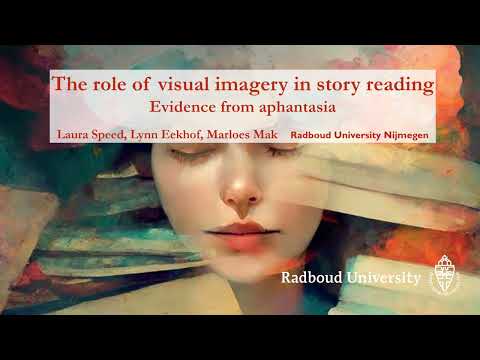 Speaker: Marloes Mak @Marloes_Mak
Speaker: Marloes Mak @Marloes_Mak
 Affiliation: Tilburg University
Affiliation: Tilburg University
 Co-authors: Laura J. Speed, & Lynn S. Eekhof
Co-authors: Laura J. Speed, & Lynn S. Eekhof
Title: The Role of Visual Imagery in Story Reading: Evidence from Aphantasia
Abstract (long version below): We explored story reading for the first time in individuals with reduced to no visual imagery. We provide initial support that visual imagery ability is critical to becoming absorbed and transported in a story world, but that it is not the only manner in which to enjoy a story. With this fascinating condition we can potentially learn what other routes to story enjoyment and language comprehension more broadly are possible beyond visual imagery.

 Long abstract
Long abstract
Aphantasia is a condition in which people experience dim or absent visual imagery (Zeman et al., 2015). This condition is prevalent in about 3-4% of the population (Dance et al., 2022). Since visual imagery is thought to play a key role in language processing and subjective reading experiences (e.g., absorption, enjoyment, transformative reading), we hypothesized the experience of a story would differ between individuals with aphantasia and controls. We tested this in an online experiment for which we specifically recruited participants with aphantasia, and asked them to read a short story. After story reading, participants were asked to complete questions about story appreciation (taken from Mak & Willems, 2019), story world absorption (Kuijpers et al., 2014), transformative reading (Fialho, In Press), reading habits, and finally some open questions about the story plot and participants’ attention to and appreciation for specific aspects of the story. To double-check that participants indeed showed decreased mental imagery, we also asked participants to complete questionnaires about the vividness of their mental imagery and their experience of aphantasia. In total, forty-seven individuals with aphantasia were compared to fifty-one matched controls. Aphantasics were less likely to be engaged with, interested in, and absorbed in the story, and experienced reduced emotional engagement with and sympathy for the story characters, compared to controls. Yet, aphantasics and controls did not differ in how much they liked or appreciated the story, and in general, the reading habits and genre preferences of the two groups did not differ either. The results suggest visual imagery may influence how a single story is experienced, but this does not seem to translate to the enjoyment of this story. Moreover, reading habits do not seem to differ between aphantasics and controls, suggesting that mental imagery (and arguable subjective reading experiences in a broader sense) is no prerequisite for reading enjoyment and reading inclination. In short, visual mental imagery does play a role in reading experiences, but it is not the only route to story enjoyment (cf. Mak et al., 2022).
References
Dance, C. J., Ipser, A., & Simner, J. (2022). The prevalence of aphantasia (imagery weakness) in the general population. Consciousness and Cognition, 97, 103243. Redirecting
Fialho, O. (n.d.). Transformative Reading (In Press). John Benjamins Publishing Company.
Kuijpers, M. M., Hakemulder, F., Tan, E. S., & Doicaru, M. M. (2014). Exploring absorbing reading experiences: Developing and validating a self-report scale to measure story world absorption. Scientific Study of Literature, 4(1), 89–122. Exploring absorbing reading experiences: Developing and validating a self-report scale to measure story world absorption | John Benjamins
Mak, M., Faber, M., & Willems, R. M. (2022). Different routes to liking: how readers arrive at narrative evaluations. Cognitive Research: Principles and Implications, 7(1), 72. Different routes to liking: how readers arrive at narrative evaluations | Cognitive Research: Principles and Implications | Full Text
Mak, M., & Willems, R. M. (2019). Mental simulation during literary reading: Individual differences revealed with eye-tracking. Language, Cognition and Neuroscience, 34(4), 511–535. https://doi.org/10.1080/23273798.2018.1552007
Zeman, A., Dewar, M., & Della Sala, S. (2015). Lives without imagery – Congenital aphantasia. Cortex, 73, 378–380. Redirecting

